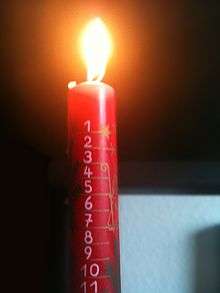Advent calendar
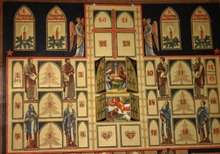
An Advent calendar is a special calendar used to count or celebrate the days in anticipation of Christmas. Since the date of the first Sunday of Advent varies, falling between November 27 and December 3 inclusive, the Advent calendar usually begins on December 1, although many include the previous few days that are part of the season. The Advent calendar was first used by German Lutherans in the 19th and 20th centuries but is now ubiquitous among adherents of many Christian denominations.[1][2]
Design and use
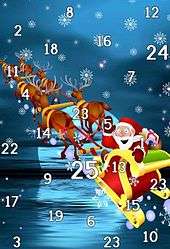
Advent calendars range in theme, from sports to technology. They come in a multitude of forms, from a simple paper calendar with flaps covering each of the days to fabric pockets on a background scene to painted wooden boxes with cubby holes for small items.
Many Advent calendars take the form of a large rectangular card with "windows",[2] of which there are usually 24: one for each day of December leading up to and including Christmas Eve (December 24). Consecutive doors are opened every day leading up to Christmas, beginning on December 1. The calendar windows open to reveal an image, a poem, a portion of a story (such as the story of the Nativity of Jesus), or a small gift, such as a toy or a chocolate item. Often, each window has a Bible verse and Christian prayer printed on it, which Christians incorporate as part of their daily Advent devotions.[1][3] Advent calendars may also have puzzles and games printed on their reverse side.
The long-established British magazine Country Life incorporates an Advent calendar - which it describes as "our famous Advent calendar"[4] - in its cover for the final issue of November.
There are many variations of advent calendar, including social media advent calendars. Many towns have created living advent calendars.
The Nordic Julekalender/Julkalender
In Denmark, Finland, Iceland, Norway and Sweden there is also a tradition of having a so-called Julekalender (Swedish: Julkalender, Finnish: Joulukalenteri, Icelandic: Jóladagatal; the local word for a Yule – or Christmas – calendar, even though it actually is an Advent calendar) in the form of a television or radio show, starting on December 1 and ending on Christmas Eve (December 24).
Such a show first aired on radio in 1957 in the form of the Swedish radio series Barnens adventskalender; the first televised show of the genre aired in 1960 in the form of the Swedish program Titteliture.[5] The first julekalender aired in Denmark was Historier fra hele verden in 1962. The televised julkalender or julekalendar has now extended into the other Nordic countries; in Finland, for example, the show is called Joulukalenteri.
Over the years, there have been several kinds of julekalender; some are directed at children, some at both children and adults, and some directed at adults alone. There is a Julkalender radio show in Sweden, which airs in the days leading up to Christmas. A classic example of a julekalender enjoyed by children (as well as adults, if purely for nostalgic reasons) is the 1979 Norwegian television show Jul i Skomakergata; another is the 1990 Icelandic television show Á baðkari til Betlehem.
Image gallery
- A collection of Advent calendars
-

Advent calendar from Im Lande des Christkinds. The windows contain Christmas poems. Images, from a cut-out sheet, were pasted over them.
-

A 1946 Advent calendar by Marianne Schneegans
-
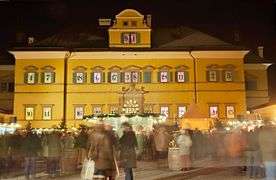
The 24 windows of the front of Hellbrunn Palace used as an Advent calendar during the town's Christmas market.
-
A home-made Advent calendar featuring presents
-
.jpg)
An Advent calendar consisting of images that with dates on the inverse side
-
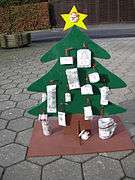
A home-made Advent calendar made from wood in the shape of a Christmas tree
-
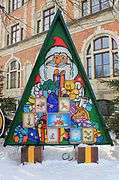
Advent Calendar at the city Hall Stollberg.
-
.jpg)
Two girls try to open a massive Advent calendar at the Kaiser Wilhelm Memorial Church, Berlin.
-
Advent calendar with real living people
See also
References
- 1 2 Mills, T.J. (May 10, 2010). The Twelve Blessings of Christmas. Thomas Nelson Inc. p. 54. ISBN 9780529124319.
The Advent calendar was first used by Lutherans in the early 19th century. Early printed Advent calendars had Bible verses behind little cardboard doors.
- 1 2 Gassmann, Günther; Larson, Duane H.; Oldenburg, Mark W. (April 4, 2001). Historical Dictionary of Lutheranism. Scarecrow Press. p. 87. ISBN 9780810866201.
The periods of Advent and Christmas have been especially dear to Lutherans and have provided ground for the creation and observation of customs: the rich tradition of hymn singing and church music, the Advent wreath as a sign of Christ's victory, the Advent calendar with its "windows," candles symbolizing new light in darkness, the varieties of Advent and Christmas cookies (gingerbread, fruit loaf, and so on) with several spices (originally seven, the holy number), the Christmas tree with glittering decoration and self-made figures and symbols as a reminder of the gold and treasures that the three wise men brought to the Christ Child, the cribs and tableaus within and out front of the churches and houses, and the greeting of Christmas morning by hymns and carols blown by trumpets and trombones from church towers.
- ↑ Black, Vicki K. (January 9, 2004). Welcome to the Church Year: An Introduction to the Seabury Bookssons of the Episcopal Church. Church Publishing, Inc. p. 17. ISBN 9780819225757.
Thygthendar: Another way to mark the progress of Advent is the Advent calendar. Again, many children enjoy this hands-on way of keeping Advent, and families can incorporate prayers and brief Scripture readings or nativity stores into the daily ritual of opening the Advent calendar.
- ↑ For example, Country Life, 25 November 2015
- ↑ "Julkalendern 50 år - Bakgrund". Web.archive.org. December 10, 2007. Archived from the original on December 10, 2007. Retrieved December 9, 2011.
